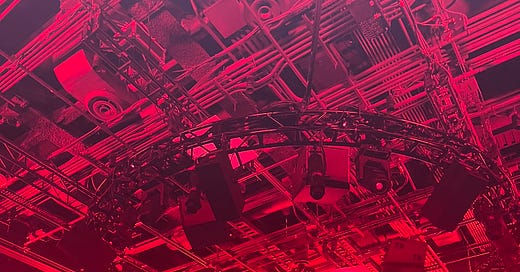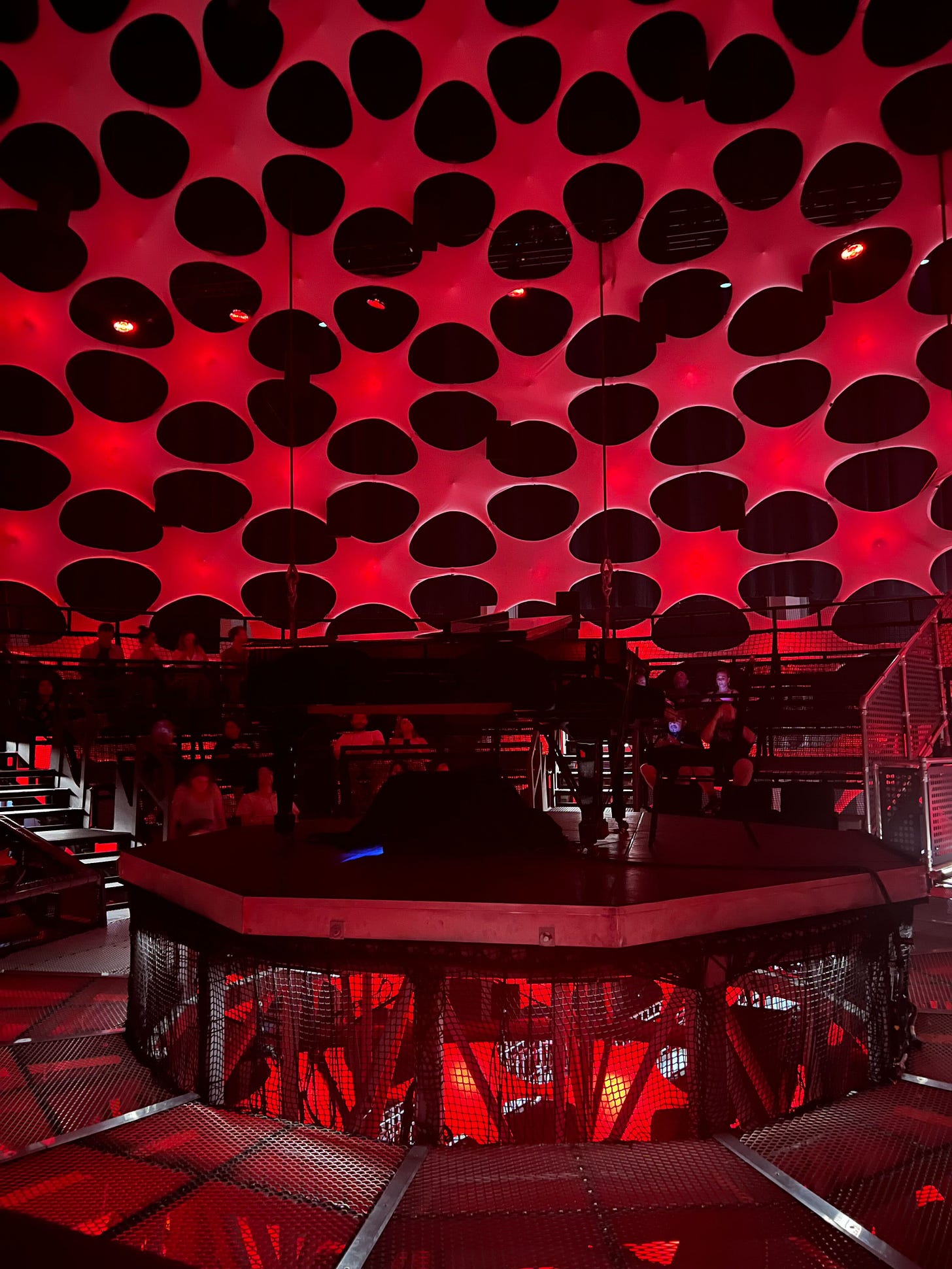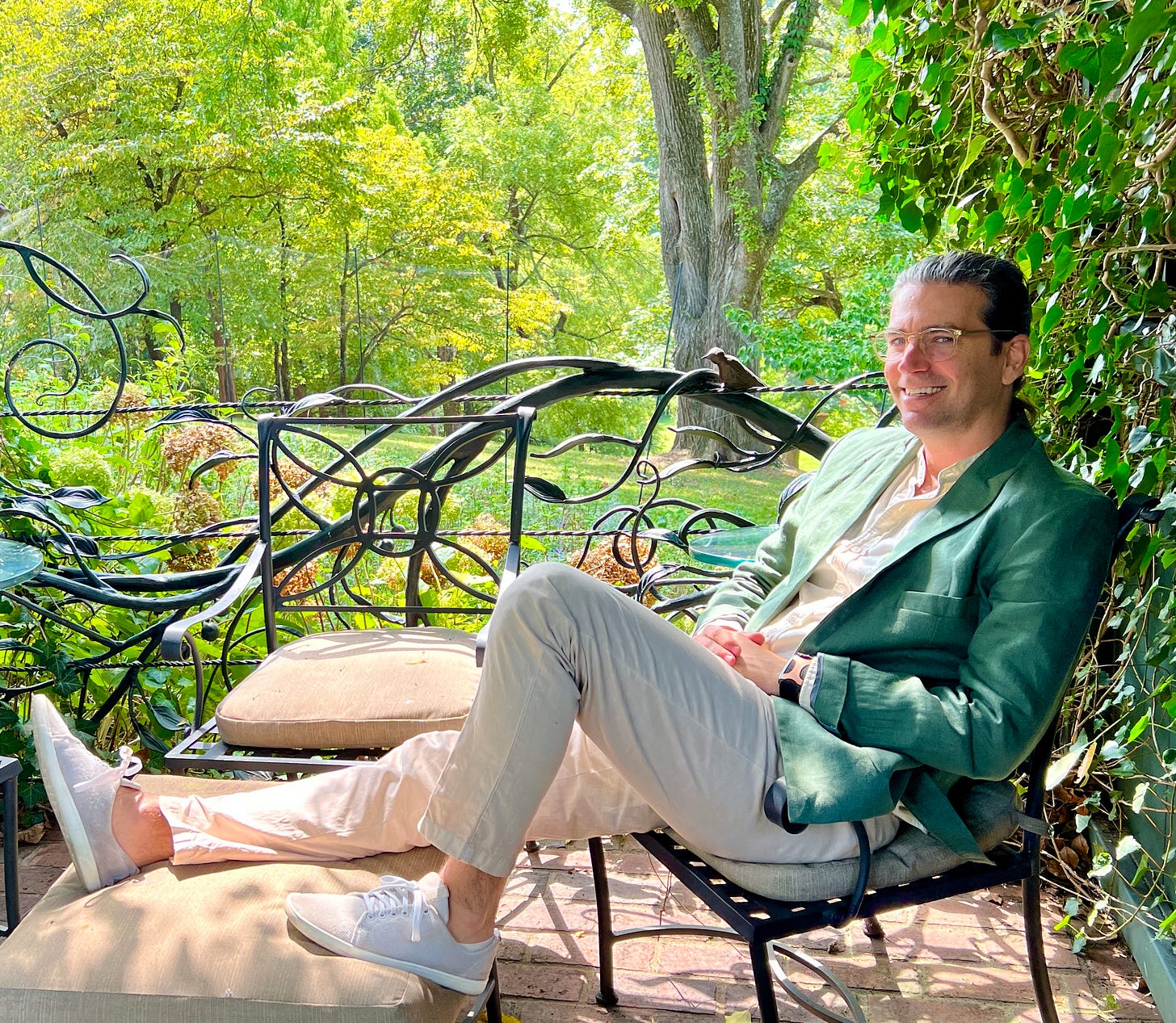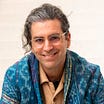Sound in a Dark Room
A Herb 'Thought Bubble' on the state of music playback, plus a very special mix from Ari Kuschnir.
This post takes its name from a song by musician/producer/friend Joshua Eustis. The song was also lovingly remixed by Ryuichi Sakamoto.
A lot of music journalism is given over to the numbers side of the business, the rates and deals, and the making of music, which in the age of mainstream AI is wild stuff. There’s a third story right now that is less salacious but picking up some steam, which I’ll lump together around the term “playback” which includes spatial audio, hi-fi, and tech-driven live or pre-recorded experiences. In short, I define playback as how we will experience music as fans, together and alone.
The music industry has thrived on the development of new mediums, mainly as reasons to further fidelity and portability which demand you upgrade your hardware (and your music library) every decade or so. Vinyl (big and small), 8-tracks, Cassettes, CDs, illegal and legal Downloads, Vinyl (again), and Streaming is a TLDR chronology that comes to mind.
It could be argued we’ve arrived at perfect portability, but the element that hasn’t fully been harnessed as a fan need is sound quality. Though it is a talking point of most of the major DSPs and hardware companies, who tout fidelity as a key attribute, and though many listeners do focus on this as a facet, it’s inconclusive to me that this is a mainstream concern enough to move the needle for most listeners. Good enough seems to be good enough for most.
The other playback concept in question is the visual side of music. Some DSPs have rolled out enhanced artwork and micro-video options, and don’t see this slowing. I’d argue the Music Video was/is a format too, in that was must-see-and-hear territory for fans, but is now largely seen as content or assets that may or may not reach their intended audience in full, but are essential to the crafting of story via social media. The concert film is increasingly more of a niche rarity (I want to see the re-mastered Stop Making Sense of course) and live-streaming, apart from major festivals doesn’t seem likely to threaten live music participation at scale.
So what's next for Sound& Vision? One concept is around the surround mix of the music itself, "spatial audio, or in branded form as Dolby Atmos which the New York Times describes as “an audio format that lets engineers create a listening experience more immersive than traditional stereo by placing sounds around and above the listener.” More and more albums are coming back in spatial audio, usually marketed to high-end headphone users and select speaker owners, and while there is a shortage of live venues that can share these records in spatial form, there will of course be more coming.
On the other end of the more technical and personal concept is the re-ignition of the Hi-Fi. Once a mainstay of enthusiasts in ‘70s and ‘80s basements and dens, the space moved from dusty, snobby equipment showrooms to the more Best Buy-friendly TV-centered variant of the 5.1 surround Home Theatre model of the ‘90-’00s (the Top Gun intro on Laserdisc was the Kind Of Blue of the epoch). But there’s been a pick-up in the prominence of the turntable/amplifier/nice speaker rig both in thoughtful venues, bars, and hotel lobby nooks as of late. A well-placed McIntosh amplifier for instance has the cooling effect of a stately wristwatch for many, an immediate signal that its owner is a person of taste and wealth.
Earlier this year I visited Devon Ojas’ listening installation at Lisson Gallery in Chelsea, accompanied by two friends (separately, on the same day), which has since traveled to London and elsewhere, gathering long lines. The speakers and hardware being handmade, take on the character of gallery art and have become feted objects by the cultural elite. Each of the two friends I brought had different responses to the work. One felt it was perhaps too fussy with a sort of anti-Hi-Fi sentiment questioning why music had to be rarified to be appreciated, which I could understand. The other’s take was that it was lovely, and the chance to sit and listen was a joy in itself.
The Hi-Fi revival (complete with Phaidon book) is perhaps an inversion or an update of the Beats headphone craze of yore, which promised to signal to others something akin to fetching sneakers, but equally mass-made and common. Hi-Fi now, post-2020, feels like a luxury good, or a ballast for serenity offering a sense of place at home or your local upscale haunt. The Ojas experience offers similar IG-ready virtues but feels more substantial (even if you can’t/don’t own one), because the programming, or who actually chooses the music and what is played, is central to the story.
Of course, the Japanese have long understood this, and the tradition of record bars or listening bars in the tradition of the Jazz kissa is a staple of urban culture which was renewed by the Hi-Fi craze of yore and holds to this day. The idea is that a record collection is decor enough and that listening is a privilege, especially when played on good hardware and served with good whisky by the person who collected these records in the first place. This concept is a hot topic and recent Substack writing by
(on former listening bar owner Haruki Murakami) and(a love letter to the concept) show its trendiness. Though Americans don’t have a culture of being quiet in public will make a true 1:1 for the concept unlikely, there have been some great variations on the theme popping up. The few I’ve been to include In Sheeps Clothing, which now has a wonderful NYC location to match its LA one, and Gold Line bar from DJ/label owner Peanut Butter Wolf which has a wall of records DJs are firmly encouraged to pull from. Both are slightly tweaking the format, but are putting sound and records front and center.There seems to be a resurgence in audio as entertainment, perhaps as a respite from screens in general. A well-appointed vinyl shelf, or for some of my nerdier friends, a great FLAC collection and headphone amp, is pushback against the degradation of sound, both in enjoyment and focus. The polarities of these arguments take on The Onion-esque humor so I assert myself somewhere in-between, but I enjoy this conversation and its evolution a great deal and think it speaks for more than just nostalgia.
Sound In A Dark Room
This Summer on a July weekend, I took to Hudson Yards, alone, to experience two playback futures. One was a holographic experience and one was a domed sound and light show. I was inspired enough to write a few notes down and recently fleshed them out.
July 2nd 2023
I had a free Saturday and ventured to The Shed (the arts/entertainment complex in the recent Hudson Yards development) to see two tech-enhanced music projects. I love a good A/C blast, a nu-commercial veneer, and the smooth, eviscerating quietude of NYC Summer, so I booked some tickets.
My first stop, after the smoothie I got from a food truck outside, was the Ryuichi Sakamoto hologram show called Kagami. Fans will know Sakamoto, who passed earlier this year and remained busy up until then, as one of the world’s most beloved musicians. He was a pioneer in electronic music, a classical and pop virtuoso, and an ecological and inspirational force.
This performance of Sakamoto at the piano is a pre-recorded one produced by the company Tin Drum, or as Max Lakin explains in his NYT piece, “Tin Drum filmed Sakamoto in Tokyo over three days in December 2020, capturing both his performance and the contours of his body with 48 cameras, an immense amount of data that took five months to process. The result represents, by their accounting, the invention of around a dozen technical processes completed by designers, scientists, and engineers in as many cities — by any measure a huge undertaking.”
The space resembled a sound stage with chairs arranged in a circle, the middle of which had no piano or screen to speak of. The ushers walked around to each of us and strapped on a headset that included a computer that hung around one’s neck. This apparatus would let you see the hologram in the center of the room that would arrive when the lights finally went out. Sakamoto, who planned for this show in life, was indeed the perfect artist for this type of project, equally popular and credible, both urbane and organic, conceptual, but all heat.
My initial feeling when the video of Sakamoto booted up was grim. I felt profoundly sad when he started playing piano, probably because we all collectively knew this was a facsimile. The way he sort of appeared out of thin air was like a seance (I promise I thought these words before I read the NYT piece), or like in a film when someone comes back to the protagonist as a waking dream, showing them appearing and then vanishing in the same frame.
There was no applause after the first few songs, and none would happen, which makes sense but also lent to the emotional distance. However, once people started standing up and walking around I cheered up a bit, almost like a dancefloor that needed warming. When people started to respectfully interact and look over his shoulder, it took on a playful quality, more like a museum than a concert.
This variant of VR and AR, or the technologies that continually stalk us as “the future” but seem to still be brewing, was compelling enough for me to be optimistic about its potential. Maybe even more so for watching speeches, or “telepresence” in lieu of Zooms, but probably still very far out for deep resonance without massive installation and R&D heft.
The first VR presentation I saw I remember clearly, as it still feels novel. It was likely in the early ’10s thanks to my friend
of m ss ng p eces (more from him below). The piece was focused on just sitting in a room watching a pianist play with his back turned to you. You couldn’t do much as a viewer but you could look around the room behind you and I think there was a cat that traipsed the space. This sort of intimacy suited the medium, evoking more mood than story.A few experimental audio experiences in recent years stuck with me. One was visiting the Oswalds Mills Audio space and hearing some of the comically biggest and most expensive speakers I’ve heard before. The playback of a Miles Davis LP was so illuminating, that it made me chuckle at how puny my headphones felt in comparison. But what about disassociating? The 32-speaker spatial array at the Envelop space in San Francisco is the closest I can think of to getting Lost in sound.
The next stop on my Saturday trip would be an entrant in the category, a few floors down in The Shed at an exhibit called Sonic Sphere. The closest comparison I can think of is the planetarium rock concerts they set for records like Dark Side Of The Moon with people getting stoned and/or making out and watching laser light shows. Entering the space had the usual Disney dark ride tropes, I felt like I was queuing up for Space Mountain.
A future for Sonic Sphere, to me, is probably most effective as medicinal in nature. i.e. a miniaturized version either in your cool uncle’s basement (back to the Hi-Fi era!) or at your local wellness or health center. These light shows used in medical or therapeutic conjunction with legal disassociates seem likely. The playlist was very good, but admittedly I couldn’t help but want the aux. I wanted my own show, and to see how songs I liked sounded (and looked) in that cavernous space. The sonic meathead in me would have played Techno. Turned all the way up until I had to close my eyes.
The two experiences put me in a good enough mood but posed more questions than provided answers. One was about connection and one about dissociation which I suppose are optimal musical spaces. The film and live performance industry also thrive on new formats (3D, 4D) like the music industry, and these projects are two tests of the question, can you automate a music experience when the artist is no longer there?
Our pesky bodies give out, but beloved music tends to hang around. It’s still fun to see the gestures of these artists in visual form like the way Sakmoto raises his hand before he goes in on a song for instance. It adds to your visual memory of the music. As far as other hologram shows, I’m eager to see the Abba Voyage show in a custom-designed theater that mixes virtual past Abba with living musicians, which seems like a winning deal (i.e. you can clap after the songs). But I can see how this future doesn't sit well with many.
Vegas seems likely to innovate here. Parents will take their kids to see artists the way they saw them growing up, with good loud audio to keep them engaged. A casino theatre could run, say, the new Usher concert (another show I want to see) for 12 months, and then when he moves on (and everything is captured well), could run 6 shows a day at tiered ticketing prices for years, with royalties being earned, etc. But this potential innovation, like other AI futures being imagined, does take a stage away from the living, which has a very sad, final quality. Some acts, like Kraftwerk, are built to be automated, and the robot show may work perfectly. For instance, the Showbiz Pizza-built band The Rock-afire Explosion is still cooking in some guy’s basement, playing Usher hits with no chance of splitting up.
Herb Sundays Presents: A Subtle, Tropical Vibration to Enjoy by Ari Kuschnir
Playlist: Apple / Spotify. Art by
My friend I mentioned above, Ari, is the founder of m ss ng p eces, an award-winning production company that has innovated in all levels of media and storytelling for as long as I’ve known him (see below). His kindness in introducing me to so many forward-thinking experiences across media and culture including the film Strozek (1977) and the breathwork of Ram Dass (not to mention his omnivorous music taste) made his mix a great fit to pair with this post on potential futures. Enjoy.
“From 2002 to 2005, I hosted a radio show in Miami called "Nu-groove" and would DJ around town. By day, I was editing somewhat cheesy Latin music videos, and by night, I embarked on a quest to discover fresh sounds emerging from Latin America while immersing myself in the classics. This unique blend of the emergent and the timeless became the distinctive essence of the radio show.
During the winter music conference of 2005, as I was preparing to relocate to New York to start the business that became m ss ng p eces, I crossed paths with Sam Valenti. Sam shared some mesmerizing Ghostly records and concluded our meeting with the words, "I believe we're destined to be friends." Eighteen years on, we’re still friends sharing music and life advice.
This mix, which translates to, “A Subtle, Tropical Vibration to Enjoy,” offers seamless blend of old and new. Classic Latin harmonies are woven in with the latest movements in Folktronica, Andes Step, and other forms of the psychedelic-infused, Latin, electronic vibes that have evolved over the past 15 years, spearheaded by labels like ZZK. As a personal touch, I’ve included some favorites from Colombia, the country where I was born and spent the first half of my life. I hope you enjoy this mellow trip. Latin America then and now. Thanks, Sam.” - Ari















